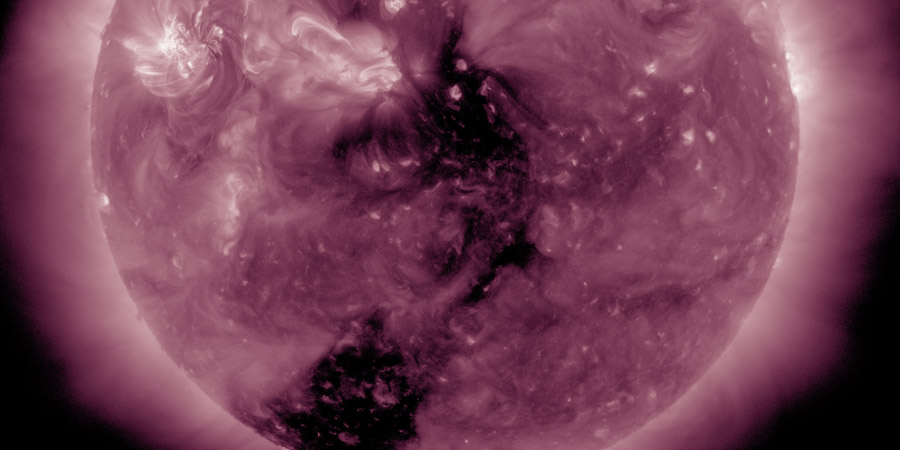Coronal hole, SpaceWeatherLive alerts
Sunday, 10 April 2016 15:23 UTC

It's that time again. We have yet another coronal hole facing Earth right now. A large northward extension of the southern hemisphere polar coronal hole that stretches all the way to the solar equator, is now in an earth-facing position. An enhanced solar wind stream could arrive on April 12 or April 13 and minor G1 geomagnetic storm conditions are possible when the solar wind stream arrives. Our header image shows this large coronal hole as captured by NASA's Solar Dynamics Observatory (SDO) in the 211 Ångström wavelength.
New SpaceWeatherLive alerts
We worked hard the past few days to realize yet another feature that we are very excited about. As most of you might know already we have a Twitter account and an email alert service where our automated SpaceWeatherLive engine publishes alerts when there is a significant space weather event. Solar flares, solar radiation storms, geomagnetic storms, radio blackouts, coronal holes... you name it and we alert you about it, 24 hours a day, 7 days a week and 365 days a year. It's always watching for significant space weather events to alert you for.
Now we went one step further with our unique alert system: we now have the possibility to send push alerts right to your computer! This will work for everyone with a Safari, Firefox or Google Chrome webbrowser. Here is what you need to do:
- When visiting SpaceWeatherLive in Safari, Firefox or Chrome you'll notice a bell icon in the downright corner, click the icon.

- Click on the button subscribe
- The browser will give a pop-up asking you to allow notifications from our website. Please give permission so you will be able to get the alerts
- A message will be displayed if it all went correctly
This signs you up for the SpaceWeatherLive alerts. You will get a welcome message which looks like this on an Android phone. It will look similar on a desktop or laptop:

If you subscribed on an Android smart phone, you will now recieve push alert notifications when there is a significant space weather event. We can unfortunately not offer the same functionalty on iOS smart phones so if you have one of those: follow us on Twitter and enable push alerts for @_spaceweather_ in your Twitter app.
If you followed all the steps correctly with a Firefox, Safari or Chrome web browser on a laptop or a desktop PC you will now be able to recieve our alerts. If you are on an Apple computer you will now recieve our space weather push alerts right on your desktop! Windows users with Google Chrome will recieve the alerts in their webbrowser. Even if you are not watching SpaceWeatherLive and doing other stuff you will still be notified of the last space weather news! You can even click on the alert and you will directly go to our site where you can follow the action live. How cool is that? We are very happy with this latest addition and we really hope our visitors will enjoy this new feature! This service is completely free to use. It won't cost you anything and you can unsubscribe from it whenever you want. No need to install an app or anything like that. Here is an example of how our coronal hole alert from this morning looks like on a Mac OS X computer:

If you are interested in reading more about our alerts, like what kind of alerts you can expect or would like to sign up for our email alerts as well then please visit this page.
Thank you for reading this article! Did you have any trouble with the technical terms used in this article? Our help section is the place to be where you can find in-depth articles, a FAQ and a list with common abbreviations. Still puzzled? Just post on our forum where we will help you the best we can!
Latest news
Latest forum messages
Support SpaceWeatherLive.com!
A lot of people come to SpaceWeatherLive to follow the Sun's activity or if there is aurora to be seen, but with more traffic comes higher server costs. Consider a donation if you enjoy SpaceWeatherLive so we can keep the website online!

Space weather facts
| Last X-flare | 2025/03/28 | X1.1 |
| Last M-flare | 2025/04/30 | M1.9 |
| Last geomagnetic storm | 2025/04/21 | Kp5+ (G1) |
| Spotless days | |
|---|---|
| Last spotless day | 2022/06/08 |
| Monthly mean Sunspot Number | |
|---|---|
| March 2025 | 134.2 -20.4 |
| April 2025 | 125.7 -8.5 |
| Last 30 days | 126.6 -0.4 |


